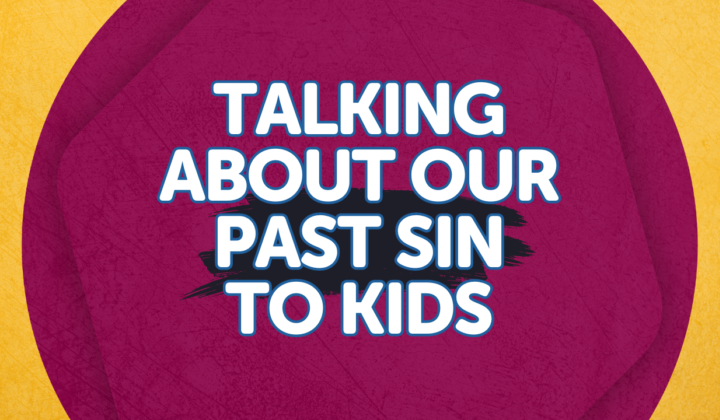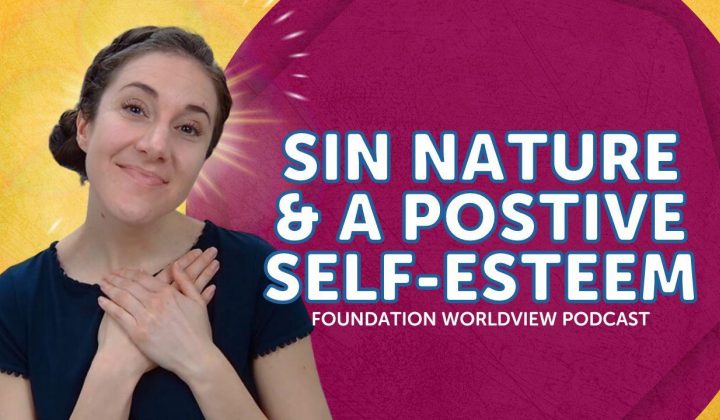Learn more about the journey that led to us equipping kids to carefully evaluate every idea they encounter.
Meet members of our team who have contributed to curriculum development.
Hear from real users of the Foundation Curriculum.
Learn what we believe about God, Jesus, Scripture, and more.
Loving Others Without Affirming Sin
In this episode, we dive into the challenging question: how can we teach our children to love others as image-bearers of God while recognizing sin without condoning it? Elizabeth Urbanowicz explores how to balance grace and truth, offering biblical insights to help parents guide their children through this delicate issue. Tune in to learn practical ways to train your children in love, discernment, and understanding the truth of God's Word.
Transcript
Note: The following is an auto-transcript of the podcast recording.
Hello friends. Today's question says, how do I teach my children the difference between loving and image bearer and affirming that person's sin? It's so easy to become the first to throw a stone, especially for young children. I don't want to foster judgmentalism in my children, but I also want to be careful to not make sin acceptable. This is a really important question for us to think through because how do we train our children to love others while also recognizing when someone is sinning without condemning that person? This is a challenging concept even for us as adults. But I want to point out right off the bat, I think that the questioner does show a biblical understanding, which is the first step, that we are not to condemn others, that only God is the judge. While we can judge between something that is right and wrong based on God's word, we are not the ones to cast judgment. Only God is the judge. Yet we're also not to view sin as acceptable or to encourage others to stay in their sin. So having this biblical understanding is the first step. So today we're going to dive down deep into how can we equip our children to love others while also recognize when others are sinning against the holy God.
For those of you I've never met before, my name is Elizabeth Urbanowicz. I'm the host of the Foundation Worldview Podcast where we seek to answer your questions so that you can equip the children that God has placed in your care to carefully evaluate every idea they encounter and understand the truth of the biblical worldview. While training children to love others will also recognize when someone is sinning is something that we seek intentionally to do in our God's Good Design curriculum here at Foundation Worldview. So as I go through answering this question, I am going to explain and model the process that we go through in that curriculum, which should hopefully help answer this question.
So the first thing that we do in our God's Good Design curriculum, and the first thing that it's important to do in order to equip children to love others while recognizing sin, is that our children first need to understand the goodness of God's design. That it's so easy for us to start off with sin and to start talking about sin. But what sin is, is sin is really a corruption of goodness. So without the goodness there could be no corruption, there would be nothing too corrupt. So we have to start off by first talking about the goodness of God's design. For example, if we want to address the sin of gossip, we first must start with the goodness of God's design for language and for communication that this is a very good thing before we jump into the corruption. If we want to discuss stealing, we have to start off with the goodness of humans being able to create and to work. If we want to about disrespecting parents, we first have to talk about the goodness of family and God-given authority. If we want to talk about why we should not watch vile content, we first need to start off with the goodness of creativity and storytelling. This is something that we do in our God's Good design curriculum before addressing the topics of transgenderism and pornography and homosexuality and divorce, we cover the goodness of God's design for our bodies, for gender, for marriage, and for family. So this is the first thing that we need to do. We need to help our children recognize the goodness of God's design. So before we just start off and point out how someone else is sinning or how we are sinning, we need to make sure that our children understand this goodness because sin is a corruption of the goodness. So without the goodness there would be no corruption. There could be no corruption. So that's the first thing we need to do.
The second thing that we need to do is we need to make sure that our children understand that deviations from God's good design are sin. So once we've laid that foundation for the goodness of God's design in a certain area, then we need to help our children understand that deviations from that good design are sin. And the way that we explain this in our God's Good Design curriculum is we say that sin is missing the mark. It's like when you're trying to shoot an arrow at a target and you miss that target. That God's goodness, God's design, who God is the mark, that God is perfect, that he is holy, and so God is the mark. And when we miss that mark, that is sin. We are missing God's good design. So we want to help our children understand that things such as gossip or stealing or disrespect or engaging in vile content, these are corruptions of God's good design. They're sin. They separate us from God, they hurt us, and they hurt others.
Now, an example that we use in our God's Good Design curriculum that I think can be a really helpful example is in that curriculum. In the video where I'm teaching this, I hold up a glass and I ask the children, okay, what is the purpose of this glass? What was it designed to do? And we talk about how the glass was designed to hold water or to hold some other kind of liquid that humans then drink. And so I model that drinking water and say, ah, this glass works so well to hold water, and when I use it according to the designer's design, it refreshes me and it rehydrates me. And then I look at the glass and I say, well, what if I decided that I wanted to turn this glass upside down? I turn the glass upside down. I say, and what if I decided that I wanted to use this glass as a stool? So I put it down on the ground upside down, and I stood on top of it, and I said, if I stood on top of it, would it lift me off the ground a little bit? Yeah, it would make me taller than I am. Now, would this glass work as well as a step stool? No, it would not work as well as a step stool, because a step stool was designed for the purpose of holding people up, of lifting them off the ground. Where I say it's possible to do this with a glass though, but I say, okay, what would eventually happen? Well, eventually this glass would crack under my weight because it was not designed to hold me up. And so eventually it would crack and it would break. It would miss out on its purpose of holding water or another liquid that humans can drink. And then what would happen to me? Well, my foot would get cut by the shards of glass, and so I would miss out on using this glass for its intended purpose, the reason the designer designed it, and I would also get hurt. Then we say it's the same with sin, that God has created our bodies and minds for some very specific purposes. And when we use our bodies and minds for those purposes according to God's good design, well then our bodies actually fulfill their purposes, and that's a good thing. Then we talk about how it's possible to use our bodies or to use our minds in ways that go against God's good design and these things are possible. And when we do these things, they're called sin because they're missing the mark. They're not going according to God's good design. But just like when we take that glass and flip it upside down and stand on it, we are going to get hurt and we're going to miss out on God's good design. So we want our children to understand that this is what sin is. It's a deviation from God's good design. It is missing the mark. Okay? So the first thing I said we need to do is we need to make sure that our children know the goodness of God's design. Second thing, we need to make sure that they understand that deviations from God's good designer sin. And then the million dollar question is, okay, Elizabeth, so what do we do now, once they recognize that sin is sin, how do we help them love others without just condemning them for their sin?
So this third thing that we need to do is we need to help our children understand how to respond when they encounter others who are blatantly sinning. Now, the first thing our kids need to understand is that all humans are created in the image of God. In God's good design curriculum. We cover this in one of our first lessons in the unit on God's good design for us, that God designed us in His image. That means that all humans have inherent dignity, value, and worth. Nothing anyone does to us or that we do to ourselves can take away the fact that we are designed in God's image. So when we're talking to our children, we want to talk to them about all people being made in God's image. That's something that even it's not easy, but when I'm stuck in traffic or when somebody cuts me off and I'm just upset on the road, what I say to myself out loud is, Elizabeth, that's an image bearer, Elizabeth, that's an image bearer. So am I frustrated that they just cut me off or they did something else in traffic? Yes, but that is an image bearer and I need to treat them as such. So that's the first truth that we need to ground them in that all humans are created in God's image. And then point out that we're going to send too. It's not just others out there who are sinful, that we are sinful as well. That is why we all need Jesus. So to understand that we're made in God's image, we are all sinful, and we can all be redeemed through the precious blood of Jesus. Now comes the part, okay, so how do we train them for when they encounter others who are blatantly sinning?
So in our God's Good Design curriculum, we directly teach the children that at their age, it is not their responsibility to point out other people's sin or to tell them that we're wrong. And we say sometimes for us as adults, it is our job to point out other people's sin, but as a child, that is not your job. And so then we teach the children three steps, and we actually have several lessons in the curriculum, or we give them example after example, after example, after example, and we talk through with them how would they implement these three steps so that they are trained to make sure that they respond in the correct way. And so the three steps we give in God's Good Design is, one, recognize this is not God's good design. Two, remind yourself of the truth. Three, be kind. So first, recognize this is not God's good design. So in that curriculum we talk about if you encounter neighbors on your block where there are two dads, or if you're at soccer camp and you encounter a little boy who is dressed as a little girl and is going by a girl's name. Okay, one, you recognize, this is not God's good design. The same thing would apply if our children have a friend who is gossiping or if they see someone who is being disrespectful to their parents. They need to recognize this is not God's good design.
Second thing, remind yourself of the truth. We teach children to do this in their minds, to practice quietly reminding themselves of the truth. So we teach them two catechizing phrases in God's Good Design for when they encounter a homosexual couple. We teach them to say in their minds, God designed marriage to be one man and one woman becoming one flesh for life. God's design is so good. And then if they encounter someone who is presenting themselves as the opposite gender, we train them to say, God designed us in His image as male or female. God's design is so good. Okay, you can teach your children other catechizing phrases for other situations. You know that God has commanded children to respect their parents. God's design is so good, or God has commanded me to use my tongue for building others up. God's design is so good. And so then have your kids practice saying these phrases in their minds.
And then three, be kind. Now caveat, if our children are in a dangerous situation, they need to get to safety. If they're with a friend who a friend is stealing, they need to leave that friend immediately, okay? They can't stay with that friend while that friend is stealing, or if they're in some other dangerous situation, they need to immediately get to safety. But if they're just encountering someone like what we talk about in God's Good Design curriculum, if they're at soccer camp and there's a little boy there who's dressed as a little girl and is going by the name Jessica, we be kind. We don't lie. We don't start calling him or her, but we invite that child to play. We ask them questions about themself. Okay, so one, recognize this is not God's good design. Two, remind yourself of the truth. Three, be kind.
So I hope that you see just with that model of what we teach children in the God's Good Design curriculum, this is something that can really be implemented in any and every situation for teaching our children the truth of loving those who are made in God's image, recognizing when others are not living according to God's good design and then loving others without just affirming their sin.
Well, that's a wrap for this episode, but if you found this content beneficial, please invest the two seconds, sometimes even just one second, it takes to give this content a five star rating if you think it's five star content. Doing so just really helps us get this content out to more people, to help them equip their kids to think critically and biblically. Also, if you have a question you would like for me to answer on a future Foundation Worldview podcast, you can submit that by going to FoundationWorldview.com/podcast. As we leave our time together, my prayer for you is that no matter the situation in which you and the children, God is placed in your care, find yourselves that you would trust that God is working all things together for your good by using all things to conform you more into the image of His Son. I'll see you next time.
Related Posts and insights

Talking About Our Past Sin to Kids
Today's question is one that we receive multiple times every year from different parents, and this question is, "How can we teach our children to understand and follow God's good design for sexuality when we as parents have not done so? Is it wrong to admit this to our children?"

Talking To Kids About Their Sin Nature without Damaging Their Self-Esteem
In this episode of the Foundation Worldview podcast, host Elizabeth Urbanowicz answers a question that many Christian parents may have: how do we teach young children about their value and worth to God while also discussing the concept of sin?

Sexuality and God's Good Design
In this episode, Elizabeth Urbanowicz answers the question, "how would you explain to kids that homosexuality and transgenderism are not what God designed? It is so counter-cultural and our kids are going to be labeled haters as time goes on if they have a biblical worldview."





